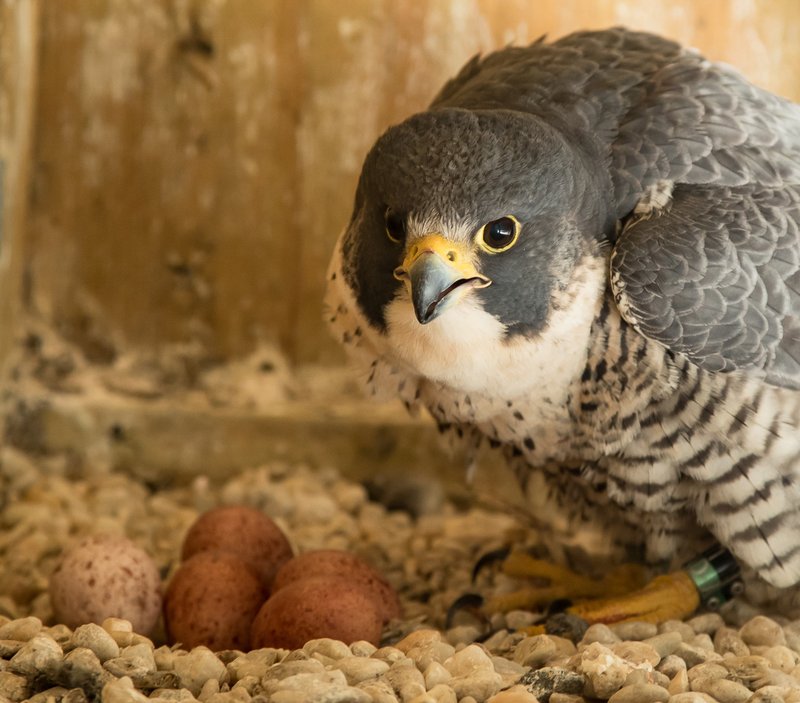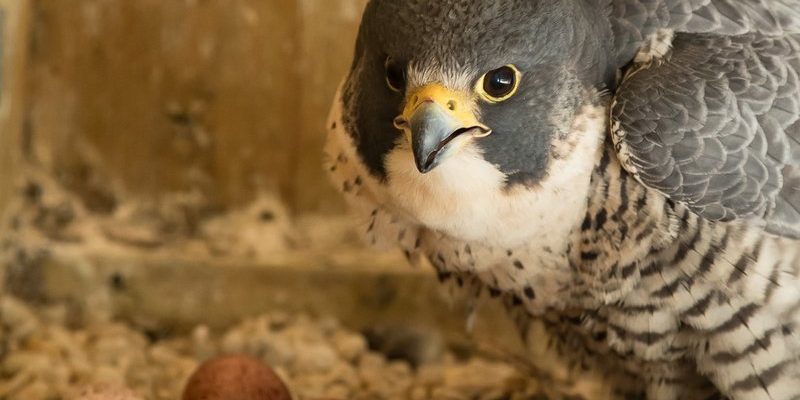
Let’s break down the nesting habits of these remarkable falcons and explore how they reproduce and raise their young. It’s not only about their lightning-fast dives but also about how they create a home in the wild. You might be surprised to learn what goes into raising a family in the avian world, especially for such a speedy creature!
Where Do Peregrine Falcons Nest?
Peregrine Falcons are known for their preference for high places. You’ll find their nests, also called **eyries**, in tall cliffs, skyscrapers, and even bridges. They choose a spot that’s usually very high off the ground. Why? It provides them with a safe vantage point to observe their surroundings and keep an eye on any potential threats.
These nests are often made by scraping out a shallow depression in gravel or soil. Think of it like a cozy little bowl that cradles their eggs. The location they select is crucial for protecting the chicks from predators, as well as providing a clear view for the parents to spot any dangers. Honestly, it’s fascinating how they adapt to both natural and urban environments, making them some of the most versatile birds out there.
Nesting Sites in Urban Areas
With urban areas sprawling, Peregrine Falcons have become quite the city dwellers. They’ve been spotted nesting on the ledges of buildings and even on the roofs of tall structures. You might wonder why they’ve chosen these bustling locations. The answer lies in the abundance of food—cities often attract pigeons and other birds, which are perfect for a falcon’s diet.
By nesting in urban environments, these falcons also find a reduction in some natural predators. It’s a fascinating example of how wildlife can adapt to changing landscapes. You might even catch a glimpse of these birds if you live in a city with tall buildings. Imagine seeing a Peregrine Falcon sitting on a ledge—nature’s speedster right in your backyard!
The Courtship Ritual
Before Peregrine Falcons settle down to nest, they go through an elaborate courtship ritual. This process begins with the male performing a series of aerial displays to impress the female. Picture him swooping and diving, showcasing his incredible speed and agility. It’s like he’s putting on a one-bird show to win her heart!
During this period, they also engage in food sharing. The male will catch prey and present it to the female, demonstrating his capabilities as a provider. This gesture not only strengthens their bond but also ensures that the female is ready for the demanding task of raising chicks. You might say that their courtship is an important prelude to the serious business of parenthood!
Once they’ve formed a bond, the Peregrine Falcons mate, and shortly after, the female lays a clutch of eggs—usually about 3 to 5 in total. These eggs are typically a pale blue or cream color, speckled with darker spots. The female will take on the primary responsibility of incubating them, ensuring they stay warm and safe until they hatch.
Incubation lasts around 29 to 32 days. During this time, the male will be busy hunting and bringing food back to the female. It’s a collaborative effort, showcasing their teamwork. Each parent plays a crucial role in keeping the family thriving, even before the chicks are born.
The Hatching Process
When the eggs finally hatch, it’s a monumental moment for the Peregrine Falcon family. Each chick, known as a **eyas**, fights its way out of the shell, a process that can take several hours. The chicks are incredibly vulnerable at this stage, covered in a soft down that won’t protect them much from the elements. The parents need to work quickly to ensure their safety.
Here’s the thing: While all the eggs usually hatch within a day or so of each other, sibling rivalry can be tough. The parents must balance their care, ensuring all the chicks get enough food and protection. As they grow, you’ll see them becoming more mobile and active. This phase is essential for their development, as they learn to strengthen their wings and build up muscle for their future flights.
Once the chicks are hatched, the parents spring into action with feeding. The male hunts for food, typically small birds and sometimes even insects. He brings prey back to the nest, where the female tears it up and feeds it to the chicks. You might think this sounds hectic, and it is! Each chick eagerly waits for its turn, often squawking loudly to get their parents’ attention.
As they grow, they start to develop more independence, but their reliance on their parents remains strong for quite some time. This nurturing behavior is crucial not just for feeding but also for teaching them the skills they’ll need one day to hunt on their own.
Fledging and Independence
About 6 to 7 weeks after hatching, the chicks are finally ready to take their first flight. This stage is known as **fledging**. It’s an exhilarating time, as they spread their wings and leave the nest for the first time. However, their first flights are often clumsy, filled with trial and error.
During this period, the parents continue to care for them, teaching them how to hunt and survive. You might envision these young falcons making awkward attempts at flight, only to be caught by a parent hovering nearby. It’s a critical learning phase that sets them up for survival in the wild.
As the fledglings gain more confidence in their flying skills, they begin to learn the art of hunting. Their parents will demonstrate the techniques needed to catch prey. This mentorship is vital, as it not only helps the young falcons develop their hunting skills but also teaches them how to navigate their territory.
After several weeks of practice, the fledglings will eventually master the skills required to fend for themselves. This transition marks a huge step toward independence, and soon enough, they’ll leave the nest to carve out their own place in the world.
Challenges They Face
Despite their impressive skills and adaptability, Peregrine Falcons face numerous challenges in the wild. Habitat loss, pollution, and climate change threaten their nesting sites and food sources. Many people also hunt them or disturb their nesting sites, which can lead to lower survival rates for their young.
Conservation efforts have helped to stabilize some populations, but it’s an ongoing fight. The more we understand about their **nesting habits** and lifecycle, the better equipped we are to protect these amazing birds. It’s essential for us as a community to advocate for their preservation, ensuring that future generations can also witness these stunning creatures in action.
The life of a Peregrine Falcon is a remarkable journey filled with speed, skill, and dedication. From their unique nesting habits to their diligent parenting, these birds embody the spirit of resilience in the wild. As they adapt to different environments and face challenges head-on, they remind us of the beauty of nature and the importance of conservation.
So, next time you see a falcon soaring high above, take a moment to appreciate the incredible lifecycle and nesting habits that have shaped this magnificent bird. Their journey is a stunning example of survival, teamwork, and the indomitable spirit of wildlife. Let’s cherish and protect these creatures, ensuring they can thrive for years to come.

